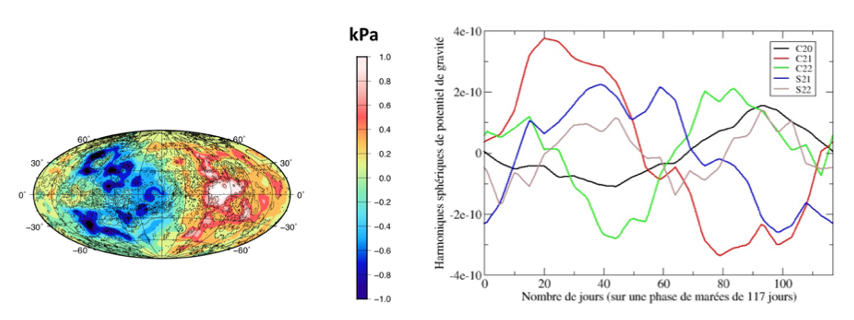Detection of the gravity signature of Venus’ thermal tides with the EnVision radio-science experiment
- 1Laboratoire de Planétologie et Géosciences, UMR-6112, Nantes Université, Université d’Angers, Le Mans Université, Nantes, France
- 2CNES/GRGS, Toulouse, France
- 3LMD/IPSL, Sorbonne Université, ENS, PSL Research University, Ecole Polytechnique, Institut Polytechnique de Paris, CNRS, Paris, France
Introduction
The thermal tides are the main cause of the atmospheric pressure variations on Venus, and are expected to generate temporal variations of the low-degree coefficients of the gravity field of the planet (Bills et al., 2020). However, these gravity variations have not yet been detected since the current Venus gravity solution is not accurate enough (Konopliv et al., 1996). In this study, we model the gravity signature of the thermal tides due to surface pressure variations and analyze whether it can be retrieved with the future tracking data of the EnVision spacecraft.
Modeling the thermal tides
The thermal tides are computed from the output of the Venus Climate Database (Lebonnois et al., 2021). The atmospheric pressure variations are derived as variations around the mean value over the tidal period of 117 Earth days (Figure 1). The associated gravity potential is computed using the following relationships (McCarthy and Petit, 2004):
where Clm(t)and Slm(t)are the time-varying part of the Stokes coefficients of the gravitational potential (land mbeing the degree and the order of the spherical harmonics expansion), R, Mand g, are the radius, the mass and the gravitational acceleration of the planet, respectively, and is the load Love number of degree l. The spherical harmonics expansion of the load variations are derived from the surface pressure variations provided by the VCD (Figure 1). This load Love number depends on the rheological properties of the internal layers of the planet (core, mantle, crust). These rheological properties mainly take into account the compressibility and the viscosity of these different layers (Dumoulin et al., 2017; Tobie et al., 2019).
The EnVision gravity experiment.
The EnVision spacecraft orbit is an elliptical orbit with an altitude range between 220 km and 515 km and an inclination of 88 degrees allowing for high-resolution mapping of the Venus gravity field (Rosenblatt et al., 2021). The EnVision gravity experiment relies on the two-way radio link established on daily passages of at least 3.5 hours long to guarantee the data download required by the EnVision payload. A very stable reference X-band frequency (at 7.1 GHz) is generated at the ground station and sent to the spacecraft, which then sends back to the station a coherent downlink frequency (X-band at 8.4 GHz) thanks to the radio-transponder of the spacecraft telecommunication system. An additional Ka-band downlink coherent frequency (32 GHz) is also sent back to Earth to support the telemetry volume requirements. This two-way X/X-Ka radio link provides a precise Doppler tracking of the EnVision spacecraft over the six Venusian days of the mission science phase.

Figure 1: Simulation of the time-varying part of the gravity field due to the surface pressure variations. Left: Map of the pressure variations extracted from the Venus Climate Database – VCD (Lebonnois et al., 2021). It is centered on longitude 180° while the sub-solar point at longitude zero degree. The main signal is dominated by the second-degree harmonics (Bills et al., 2020). Right:time-variations of the second-degree harmonics of the gravitational potential due to the pressure variations over one tidal cycle (117 Earth-days).
Simulations of the retrieval of time-varying gravitational potential from the future EnVision tracking data
On the basis of the modeling of the thermal tides, we perform simulations of the EnVision gravity experiment following the procedure described in details in Rosenblatt et al. (2021). We thus use the GINS (Géodésie par Intégrations Numériques Simultanées) software developed by CNES (Marty et al., 2009). We simulate the EnVision tracking data with and without the contribution of the time-varying gravitational potential generated by the thermal tides. Then, we perform least squares fit of the difference between both simulated tracking dataset in order to assess the capacity to retrieve the temporal variations of the gravity field due to the thermal tides. The Doppler noise budget and other source of errors in the Precise Orbit Determination process are also taken into account as in Rosenblatt et al. (2021). The goal of this study is in particular to assess our ability to correct the effect of the thermal tides on the estimation of the k2 tidal potential Love number (real and imaginary part).
References:
Bills B.G. et al. (2020), Icarus, 340, article id. 113568 ; Dumoulin C., et al. (2017), Planets, 122 (6), 1338-1352; Konopliv A.S. & Sjogren W.L. (1996). JPL Publication 96-2 1996; Jet Propulsion Laboratory: Pasadena, CA, USA ; Lebonnois S. et al. (2021). The Venus Climate Database. EPSC2021-234, Europlanet Science Congress 2021, virtual meeting, 13-24 September, 2021; Marty J.C. et al. (2009), Planet. Space Sci. 2009,57, 350–363; McCarthy D.D. & Petit G. (Eds.) IERS Conventions (2003); IERS Technical Note 32; BKG: Frankfurt/Main, Germany, 2004; Rosenblatt P. et al. (2021),Remote Sensing, vol. 13, 1624; Tobie G. et al. (2019), Astronomy & Astrophysics, 630, id.A70, 11 pp.
How to cite: Rosenblatt, P., Marty, J.-C., Tobie, G., Dumoulin, C., and Lebonnois, S.: Detection of the gravity signature of Venus’ thermal tides with the EnVision radio-science experiment, Europlanet Science Congress 2022, Granada, Spain, 18–23 Sep 2022, EPSC2022-566, https://doi.org/10.5194/epsc2022-566, 2022.

